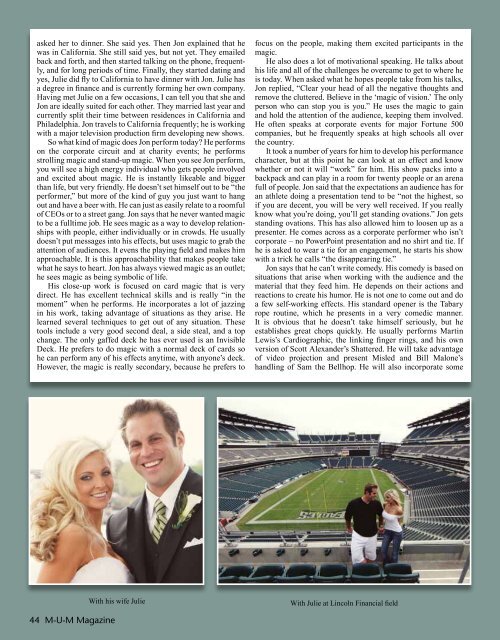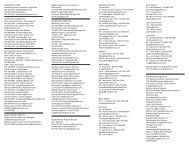(Hank) Moorehouse 1934 – 2011 - The Society of American Magicians
(Hank) Moorehouse 1934 – 2011 - The Society of American Magicians
(Hank) Moorehouse 1934 – 2011 - The Society of American Magicians
Create successful ePaper yourself
Turn your PDF publications into a flip-book with our unique Google optimized e-Paper software.
asked her to dinner. She said yes. <strong>The</strong>n Jon explained that he<br />
was in California. She still said yes, but not yet. <strong>The</strong>y emailed<br />
back and forth, and then started talking on the phone, frequently,<br />
and for long periods <strong>of</strong> time. Finally, they started dating and<br />
yes, Julie did fly to California to have dinner with Jon. Julie has<br />
a degree in finance and is currently forming her own company.<br />
Having met Julie on a few occasions, I can tell you that she and<br />
Jon are ideally suited for each other. <strong>The</strong>y married last year and<br />
currently split their time between residences in California and<br />
Philadelphia. Jon travels to California frequently; he is working<br />
with a major television production firm developing new shows.<br />
So what kind <strong>of</strong> magic does Jon perform today? He performs<br />
on the corporate circuit and at charity events; he performs<br />
strolling magic and stand-up magic. When you see Jon perform,<br />
you will see a high energy individual who gets people involved<br />
and excited about magic. He is instantly likeable and bigger<br />
than life, but very friendly. He doesn’t set himself out to be “the<br />
performer,” but more <strong>of</strong> the kind <strong>of</strong> guy you just want to hang<br />
out and have a beer with. He can just as easily relate to a roomful<br />
<strong>of</strong> CEOs or to a street gang. Jon says that he never wanted magic<br />
to be a fulltime job. He sees magic as a way to develop relationships<br />
with people, either individually or in crowds. He usually<br />
doesn’t put messages into his effects, but uses magic to grab the<br />
attention <strong>of</strong> audiences. It evens the playing field and makes him<br />
approachable. It is this approachability that makes people take<br />
what he says to heart. Jon has always viewed magic as an outlet;<br />
he sees magic as being symbolic <strong>of</strong> life.<br />
His close-up work is focused on card magic that is very<br />
direct. He has excellent technical skills and is really “in the<br />
moment” when he performs. He incorporates a lot <strong>of</strong> jazzing<br />
in his work, taking advantage <strong>of</strong> situations as they arise. He<br />
learned several techniques to get out <strong>of</strong> any situation. <strong>The</strong>se<br />
tools include a very good second deal, a side steal, and a top<br />
change. <strong>The</strong> only gaffed deck he has ever used is an Invisible<br />
Deck. He prefers to do magic with a normal deck <strong>of</strong> cards so<br />
he can perform any <strong>of</strong> his effects anytime, with anyone’s deck.<br />
However, the magic is really secondary, because he prefers to<br />
44 M-U-M Magazine<br />
focus on the people, making them excited participants in the<br />
magic.<br />
He also does a lot <strong>of</strong> motivational speaking. He talks about<br />
his life and all <strong>of</strong> the challenges he overcame to get to where he<br />
is today. When asked what he hopes people take from his talks,<br />
Jon replied, “Clear your head <strong>of</strong> all the negative thoughts and<br />
remove the cluttered. Believe in the ‘magic <strong>of</strong> vision.’ <strong>The</strong> only<br />
person who can stop you is you.” He uses the magic to gain<br />
and hold the attention <strong>of</strong> the audience, keeping them involved.<br />
He <strong>of</strong>ten speaks at corporate events for major Fortune 500<br />
companies, but he frequently speaks at high schools all over<br />
the country.<br />
It took a number <strong>of</strong> years for him to develop his performance<br />
character, but at this point he can look at an effect and know<br />
whether or not it will “work” for him. His show packs into a<br />
backpack and can play in a room for twenty people or an arena<br />
full <strong>of</strong> people. Jon said that the expectations an audience has for<br />
an athlete doing a presentation tend to be “not the highest, so<br />
if you are decent, you will be very well received. If you really<br />
know what you’re doing, you’ll get standing ovations.” Jon gets<br />
standing ovations. This has also allowed him to loosen up as a<br />
presenter. He comes across as a corporate performer who isn’t<br />
corporate <strong>–</strong> no PowerPoint presentation and no shirt and tie. If<br />
he is asked to wear a tie for an engagement, he starts his show<br />
with a trick he calls “the disappearing tie.”<br />
Jon says that he can’t write comedy. His comedy is based on<br />
situations that arise when working with the audience and the<br />
material that they feed him. He depends on their actions and<br />
reactions to create his humor. He is not one to come out and do<br />
a few self-working effects. His standard opener is the Tabary<br />
rope routine, which he presents in a very comedic manner.<br />
It is obvious that he doesn’t take himself seriously, but he<br />
establishes great chops quickly. He usually performs Martin<br />
Lewis’s Cardiographic, the linking finger rings, and his own<br />
version <strong>of</strong> Scott Alexander’s Shattered. He will take advantage<br />
<strong>of</strong> video projection and present Misled and Bill Malone’s<br />
handling <strong>of</strong> Sam the Bellhop. He will also incorporate some<br />
With his wife Julie With Julie at Lincoln Financial field



